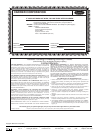
Combustion Area and Vent System — The com-
bustion area and vent system should be visually inspected
before each heating season. The normal accumulation of dirt,
soot, rust, and scale can result in loss of efficiency and im-
proper performance if allowed to build up.
If your unit makes an unusual or especially loud noises
during heating, shut down the heating section and call
your dealer.
See Fig. 1A, 1B and 5 and proceed as follows to inspect
the combustion area and power-venting system of your unit.
1. Turn off gas supply to your unit.
2. Turn off electrical power to your unit.
3. Remove burner access panel.
4. Using a flashlight, carefully inspect the burner areas for
dirt, soot, or scale.
If dirt, soot, rust, or scale accumulations are found,
call your dealer and do not operate your heating sec-
tion.
5. When you have completed your inspection, follow the
start-up procedures in this manual to restore your unit to
operation.
6. Observe unit heating operation.
Components in heat section may be hot after unit
has been started up. When observing flame, be care-
ful not to get to close to or touch heating compo-
nents. Serious personal injury may result.
Watch the burner flame to see if it is bright blue. If you
observe a suspected malfunction or that the burner flame
is not bright blue, call your dealer.
7. Replace burner access panel.
Unit Panels — After performing any maintenance or serv-
ice on the unit, be sure all panels are securely fastened in
place to prevent rain from entering unit cabinet and to pre-
vent disruption of the correct unit airflow pattern.
REGULAR DEALER MAINTENANCE
In addition to the type of routine maintenance you might
be willing to perform, your unit should be inspected regu-
larly by a properly trained service technician. An inspection
(preferably each year, but at least every other year) should
include the following:
1. Inspection of all flue product passages — including the
burner, heat exchanger, and flue collector box.
2. Inspection of all combustion- and ventilation-air pas-
sages and openings.
3. Close inspection of all gas pipes leading to and inside
your unit.
4. Inspection, and if required, cleaning of the condenser
and evaporator coils.
5. Inspection, and if required, cleaning of the condensate
drain pan and trap.
6. Inspection and cleaning of blower wheel housing and
motor.
7. Inspection of all supply- and return-air ducts for leaks,
obstructions, and insulation integrity.Any problems found
should be resolved at the time of inspection.
8. Inspection of the unit base for cracks, gaps, etc., which
may cause a hazardous condition.
9. Inspection of the unit casing for signs of deterioration.
10. Inspection of all electrical wiring and components to en-
sure proper connection.
11. Inspection for leaks in the refrigerant circuit. Pressure-
check to determine appropriate refrigerant charge.
12. Inspection and cleaning of fan wheels and housings, belt
tension, and fan motor and shaft bearings.
13. Operational check of the unit to determine working con-
ditions. Repair or adjustment should be made at the time
of inspection.
Your servicing dealer may offer an economical service con-
tract that covers seasonal inspections. Ask for further de-
tails.
Complete Service Instructions can be found in the unit
Installation, Start-Up and Service Instructions.
Fig.5—Typical Heat Section Detail
(Size 004-007 Shown)
INDUCED-DRAFT
MOTOR
GAS VALVE
6










